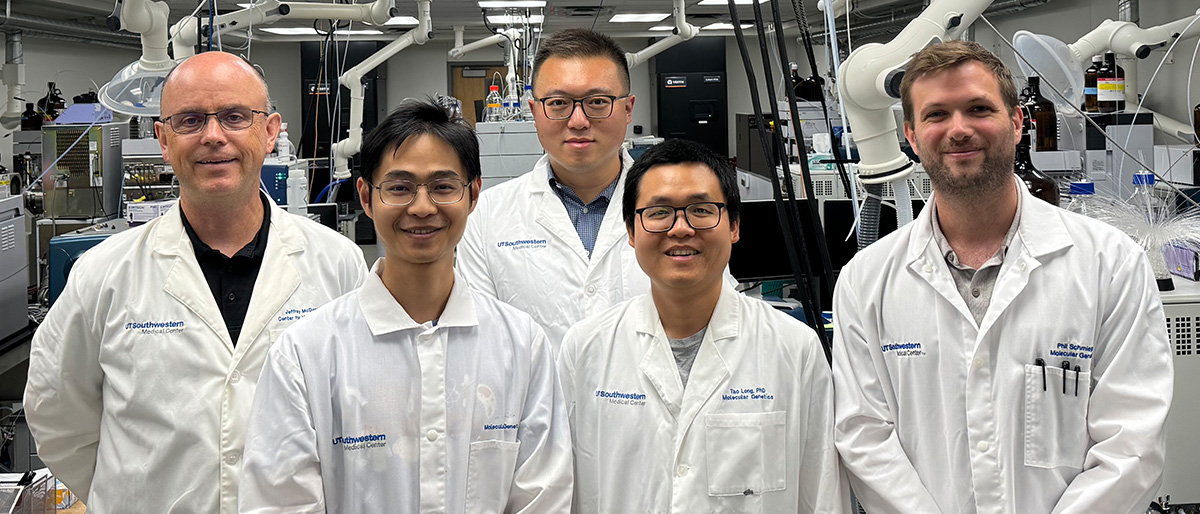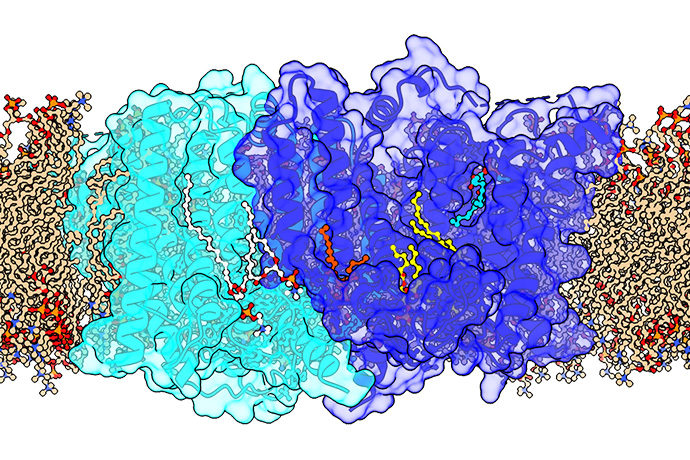Enzyme inhibitors have potential to reduce ‘bad’ LDL cholesterol, study reveals

UT Southwestern scientists have discovered a novel way to block uptake of the “bad” form of cholesterol, opening a research path toward a potential new treatment for cardiovascular disease.
The investigation focuses on an enzyme called PSS1 (phosphatidylserine synthetase 1), which produces one of the fatty molecules that make up cell membranes.
“We think this can lead to a new class of drugs,” said Xiaochun Li, Ph.D., Associate Professor of Molecular Genetics and Biophysics. “PSS1 could be a promising target for reducing blood cholesterol levels.”
The study, published Aug. 28 in Cell, is part of ongoing work by UTSW to fully understand cholesterol metabolism and find ways to fight cardiovascular disease, building on earlier landmark studies from UTSW Professors Michael Brown, M.D., and Joseph Goldstein, M.D.

Drs. Brown and Goldstein were awarded the 1985 Nobel Prize in Physiology or Medicine for their discovery of the low-density lipoprotein (LDL) receptor, which transports LDL, or “bad” cholesterol, into cells. Their research led to the development of statin drugs used worldwide to reduce illness and death in people with cardiovascular disease. The pair also discovered the SREBP (sterol regulatory element binding proteins) system, which is involved in cellular uptake of cholesterol.
Dr. Brown is Director of UTSW’s Erik Jonsson Center for Research in Molecular Genetics and Human Disease while Dr. Goldstein is Chair of Molecular Genetics. Both are Professors of Molecular Genetics and Internal Medicine.
Other related UTSW research led to knowledge about PCSK9, a protein that interacts with the LDL receptor. People with naturally low levels of cholesterol were found to have a mutation that deactivates PCSK9; anti-PCSK9 antibodies for lowering cholesterol were approved by the Food and Drug Administration in 2015. This foundational work came from the Dallas Heart Study, when Helen Hobbs, M.D., Professor of Internal Medicine and Molecular Genetics and former Director of the Eugene McDermott Center for Human Growth and Development, and Jonathan Cohen, Ph.D., Professor of Internal Medicine, in the Center for Human Nutrition, and in the McDermott Center, discovered this link between PCSK9 gene mutations and reduced cholesterol.
Dr. Li’s investigation focuses on the structure and function of cell-membrane receptors. He and his colleagues studied the PSS1 enzyme using cryo-electron microscopy, an advanced technology that captures images of structures at atomic-level resolution.
They then tested the relationship between PSS1, the SREBP pathway, and LDL in hamster ovary cells and found that inhibiting PSS1 triggers SREBP activity to increase LDL uptake. Cells digest excess cholesterol after they take it in, so blood cholesterol levels go down.
“This is just the beginning of this exciting new research direction. The next step is to test whether PSS1-specific inhibitors can reduce blood cholesterol levels,” Dr. Li said. “Further studies are needed to determine whether targeting PSS1 could either serve as a statin alternative or be used in conjunction with statins to lower blood cholesterol levels.”
Dr. Brown, a Regental Professor, holds The W.A. (Monty) Moncrief Distinguished Chair in Cholesterol and Arteriosclerosis Research, and the Paul J. Thomas Chair in Medicine.
Dr. Cohen holds the C. Vincent Prothro Distinguished Chair in Human Nutrition Research.
Dr. Goldstein, a Regental Professor, holds the Julie and Louis A. Beecherl, Jr. Distinguished Chair in Biomedical Research, and the Paul J. Thomas Chair in Medicine.
Dr. Hobbs holds the Dallas Heart Ball Chair in Cardiology Research.
Dr. Li is a Rita C. and William P. Clements, Jr. Scholar in Biomedical Research.

